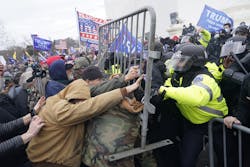Like many Americans, I watched the Jan. 6, 2021, assault on the U.S. Capitol with horror. Watching as a national American monument disgraced by our own in an attack of domestic insurrection was surreal. As a former Secret Service Special Agent, I knew a lot of people who worked in the building. I worried for their safety, wondering if they were sheltering in place, or if they were actively engaging and fighting with the insurrectionists.
A year later, we’ve had a chance to assess and get a better picture of how security failed and why, and to make a number of changes to prevent a similar breach. However, the lessons learned from Jan. 6 are not simple fixes. They will require a commitment on the part of law enforcement, the military, and government authorities to face the threat of domestic terror with a united front.
Could the attack have been prevented? I think so. If it had been treated as a true national security event should, I do think it would have been prevented. While hindsight is always 20/20, here are a couple of things that jump immediately to mind:
- Insufficient manpower. What we saw were the Capitol Police being overwhelmed – not by weapons or machines, but by sheer numbers. If the Capitol Police, along with state and local resources, could have joined forces with the police, they could have turned back the attack.
- Proper physical barriers. The bike rack barriers were too close to the steps. Even something as simple as moving barriers back from the actual steps of the Capitol would have been effective in slowing or stopping the perpetrators.
- Electronic security. If electronic building security – card readers, electronic access, surveillance cameras, and more – had been reinforced, it could have prevented individuals from entering the building, or from moving freely throughout the halls and offices.
Since the attack, the changes put in place take into account the events of Jan. 6. They have closed the vulnerabilities and are aimed at preventing another attack. These new protocols are not static – they will have to be constantly monitored, tested, and upgraded to meet new threats.
Standard Security Protocol
Perhaps the biggest change post-Jan. 6 is that there is now a protocol for when the Capitol Police conduct a risk assessment before a large-scale event. If they determine there are vulnerabilities in their security plan, they can request additional operational security. This is a huge change.
As we remember from a year ago, there was a great deal of confusion about whether or not additional forces such as the National Guard could be mobilized, or even if the Capitol Police could request their help. The delay allowed the insurrectionists the opportunity to overwhelm the police and break into the building.
Now, a standard protocol has been established. When this type of national security event occurs, there are individuals who make the decisions at the top to request additional aid or manpower. There is a proper channel to communicate security issues.
In my opinion, this is the most important change. The Capitol Police’s response was handicapped because it was unclear who would make the call, or even which department would respond. Officers had no clear understanding of how to act. That failure led to the resignations of House Sergeant at Arms Paul Irving, Senate Sergeant at Arms Michael Stenger, and Capitol Police Chief Steve Sund.
Upgraded CCTV
Another failure – a black eye on the Capitol, really – was the CCTV system. Certainly, it was a great tool for investigative purposes in identifying individuals. But the Capitol CCTV system only had a set amount of time of TV footage they could actually review. It didn’t allow for the archiving of footage or recordings.
That has now been changed. All CCTV footage is now archived, so investigators going forward have access to that information.
Enhanced Physical Security
The Capitol has traditionally been called the People’s House. After Jan. 6, that changed. They’ve reduced the number of public entrances, which is where the Capitol Police can concentrate their security. The other access points have been hardened. Electronic security has also been beefed up, because of the potential for a cyberbreach.
Typically, cybersecurity and physical security go hand in hand, because so much of physical security systems and building infrastructure are computer controlled. The Capitol now has new computer hardware firewalls. Other elements that have been upgraded to national security standards include card readers, electric door locks, surveillance cameras, and the HVAC system.
More to be Done
There’s still more work to be done, and a commitment to better understanding why the insurrection took law enforcement by surprise. Several intelligence assessments early on basically laid out the assault. There were plenty of warning signs. Unfortunately, due to a number of issues, these threats were not responded to appropriately.
Unfortunately, this failure harkens back to 9/11. There were warning signs then as well, and they weren’t heeded. This is an indication that we need to do a better job of communicating these assessments to all the parties involved.
The Jan. 6 commission, like its predecessor the 9/11 commission, is a bipartisan commission formed to get past this red tape and identify measures to prevent an attack from happening again. Because again, the warning signs were there. We have to get better at responding appropriately and effectively.
One warning sign may be the existence of individuals in the federal government, law enforcement and the military who share the beliefs of the insurrectionists. I think the number of people who had ties to the government and the military who were involved in the attack surprised us all. Any time there is an internal threat, this poses big risks. And I believe that internal threats outweigh those from the outside.
In response to this intelligence, agencies and other government organizations have conducted top-down audits of personnel to flush out those who are sympathizers to the insurrectionists.
Wake Up Call
Jan. 6 changed the way we think about national security and domestic terrorism. The insurrection put it right in front of our face. All too often, we watch CNN, MSNBC or Fox News and we see coups happen in other countries. We never think it could happen here. On Jan. 6, it almost did. That should shock and horrify us, not just here, but also when it happens in other countries as well.
The attack didn’t come out of the blue. We need to come together in the political, educational, and business arenas to understand why the individuals involved in the Jan. 6 attack decided to commit that act. Ultimately, we are all responsible for what happened, and we should all work together to ensure that it doesn’t happen again.
About the Author:
Dr. Brian Gant is an Assistant Professor of Cybersecurity at Maryville University, with over 18 years of Corporate and Federal Government experience in analytics, threat intelligence, critical infrastructures and executive protection.



